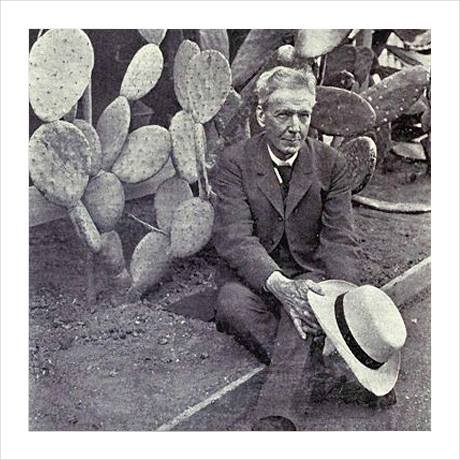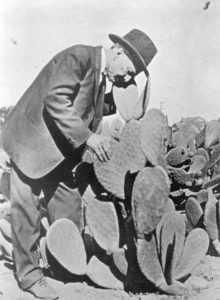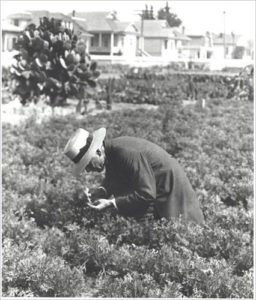
Luther Burbank, 1849 – 1926
Luther Burbank was born on March 7th, 1849, on a farm near Lancaster, Massachusetts. He received little more than a high school education, but showed interest in nature and mechanics at an early age. Among his early inventions were a steam engine for his rowboat, and a steam whistle made from combining a willow stick and an old teakettle. His enthusiasm for nature was encouraged by his uncle, the head of a department of a Boston museum, and his uncle’s friend, Swiss-American naturalist Louis Agassiz.
After his father’s death, Burbank moved with his family to a small farm in Groton. At the age of 21, he purchased 17 acres of land near Lunenberg, Massachusetts, and began a 55-year plant-breeding career. Inspired by Charles Darwin’s Variation of Animals and Plants Under Domestication, Burbank determined that better plants and new varieties could be developed with natural selection through crossbreeding (hybridization).
Burbank’s first successful plant was developed through careful selection. In 1871, he found a potato seed ball and planted its 23 seeds in a special plot. One of the seeds produced many large, firm potatoes. Burbank replanted these and reaped a small harvest of fine potatoes. He sold the rights to the potato for $150 for travel fare to California, where three of his brothers had already settled. In Santa Rosa, he established a nursery garden and greenhouse that became famous throughout the world. In 1885, he bought 18 acres nearby in Sebastopol, and created his experimental farm where he ultimately produced many of his famous creations.
I firmly believe, from what I have seen, that this is the chosen spot of all this earth as far as Nature is concerned. — Luther Burbank 1849-1926

His standard process was creating multiple crosses of foreign and native strains to obtain seedlings, which he grafted onto fully developed plants for rapid assessment of hybrid characteristics. He carried on his plant hybridization and selection on a huge scale. At any one time, he maintained as many as 3,000 experiments involving millions of plants. In his work on plums, he tested about 30,000 new varieties. Much of his valuable data was lost, but he wrote several books. Luther Burbank, His Methods and Discoveries and Their Practical Applications was published in 12 volumes in 1914-15.
Burbank died in Santa Rosa on April 11, 1926. The Plant Patent Act of 1930 amended U.S. patent law to permit protection of new and distinct varieties of asexually reproduced plants, other than tuber-propagated plants. This legislation resulted from the growing awareness that plant breeders had no financial incentive to enter plant breeding because they could not exercise control over their discoveries. In supporting this legislation, Thomas A. Edison testified: “This (bill) will, I feel sure, give us many Burbanks.”
Major Plant Contributions

- POTATO: ‘Burbank’
- FRUITS: 113 Plums and Prunes, 10 Different Apples, 16 Blackberries, 13 Raspberries, 10 Strawberries, 35 Fruiting Cacti, 10 Cherries, 2 Figs, 4 Grapes, 5 Nectarines, 8 Peaches, 4 Pears, 11 Plumcots, 11 Quinces, 1 Almond, 6 Chestnuts, 3 Walnuts
- GRAINS, GRASSES AND OTHER FORAGE: 9 Different kinds
- VEGETABLES: 26 Different kinds
- ORNAMENTALS: 91 Different kinds.
– Excerpt from Luther Burbank’s Plant Contributions By Walter L. Howard | University of California | Bulletin 691| March 1945.
Luther Burbank was inducted into the Inventor’s Hall of Fame in 1986. Plant Patent Nos. 12, 13, 14, 15, 16, 18, 41, 65, 66, 235, 266, 267, 269, 290, 291, and 1041 were issued to Burbank posthumously.
Unique Laboratory
The Experiment Farm in Sebastopol is where Burbank created many of his experiments. Some of these experimental hybrids from over 90 years ago are still visible at the farm, as well as other unique Burbank creations. Note that this outdoor laboratory is unique in the world — some experiments were only half finished by Burbank during his lifetime, and therefore the plant hybrids can be found nowhere else on the planet.
Assessment of Luther Burbank’s Life Work
“The science of breeding grew and advanced rapidly during the first two decades of the new century, and though it may not be generally recognized, the movement is traceable to Burbank as a potent activator.” According to Professor H. J. Webber, a pioneer plant-breeder and geneticist and a contemporary of Burbank. “Because of the influence of Burbank, the science of plant breeding was advanced by at least twenty years and for this accomplishment alone, he deserved a sizable monument to his memory.” (From Luther Burbank A Victim of Hero Worship, by Walter L. Howard, Emeritus Professor of Pomology, University of California, in Chronica Botanica, 1945)
Burbank, Luther, 1849-1926 Luther Burbank: his methods and discoveries and their practical application (1914), 12 complete volumes digitized for public use.
A recent article assesses Luther Burbank’s work: Journal of Heredity.